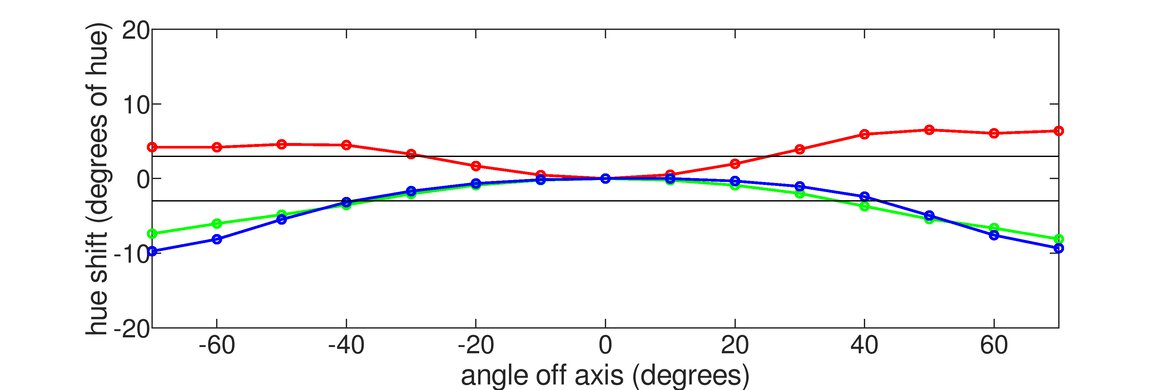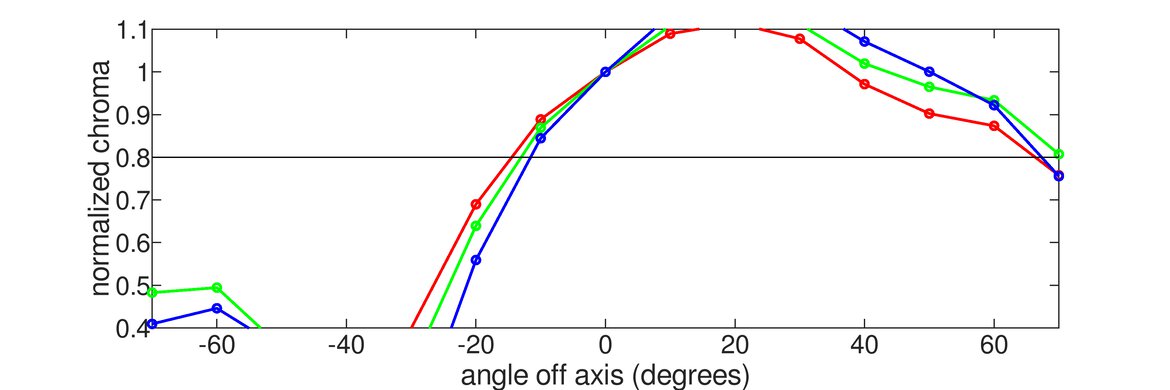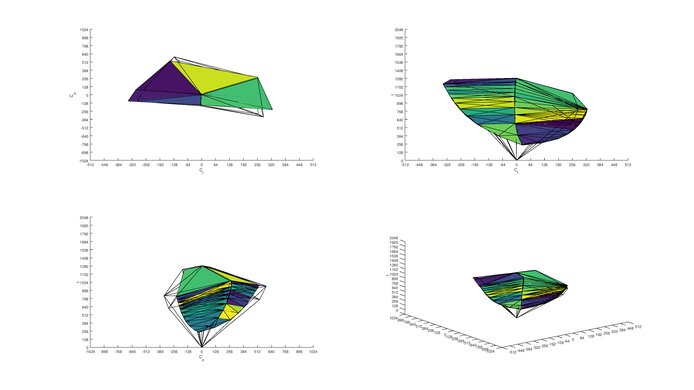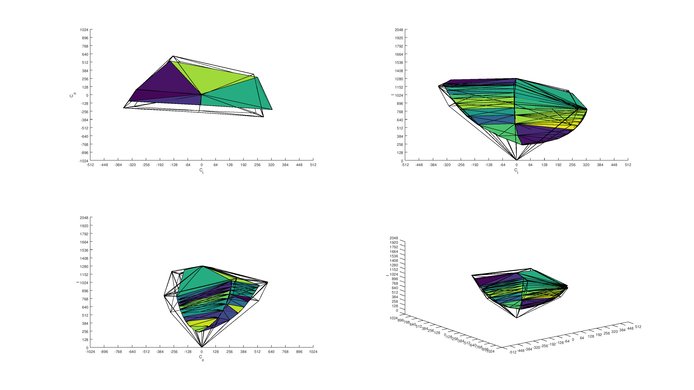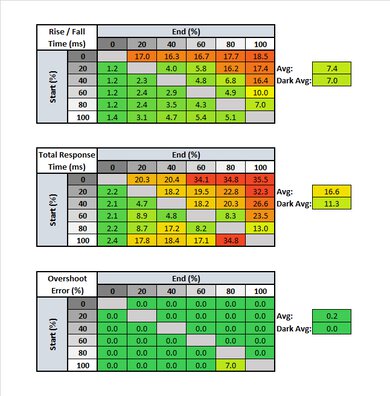The Samsung U28E590D is an average 4k 28 inch monitor with a TN-type LCD. It has a high resolution and a larger than average screen size giving it good usable space. Unfortunately, its picture quality is poor, and its very low viewing angle means it's impossible to have a uniform picture. It also lacks support for wider color gamuts or HDR, and its stand leaves a lot to be desired.
Our Verdict
The Samsung U28E590D is a mediocre monitor for mixed usage. The lackluster picture quality and very narrow viewing angle mean its performance is below average on a few basic elements for a good monitor. Its higher resolution and larger size are otherwise good features. Its stand is also less than stellar, offering very few adjustments.
- High 4k resolution.
- Disappointing picture quality.
- Very narrow viewing angle.
- Stand has limited flexibility.
The Samsung U28E590D is alright for use in an office environment. While its high resolution is useful for productivity, its very narrow viewing angles and poor ergonomics reduce its practicality in team-oriented workplaces, as sharing your screen with neighboring colleagues is less intuitive.
The Samsung U28E590D does a decent job with video games thanks to its low input lag and motion blur. Unfortunately, however, its poor picture quality reduces immersion and it lacks more advanced features like G-Sync and high refresh rates. Its higher 4k resolution is quite enjoyable, though.
The Samsung U28E590D is only okay for multimedia. The inadequate picture quality makes it less interesting for watching movies or other content in a dark room. It does have a 4k resolution which helps make UHD movies look sharp, but it lacks support for HDR or wide color gamuts for an even better picture.
The Samsung U28E590D is alright for media creators. Its lack of support for wider gamuts and poor uniformity make it difficult to remain accurate. Furthermore, its poor viewing angle means that colors are likely to have meddling accuracy regardless of your viewing position.
The Samsung U28E590D does not support HDR.
Changelog
- Updated Jul 02, 2021: Changed height adjustment result from 'N/A' to '0' to match our methodology.
- Updated Jul 13, 2020: Converted to Test Bench 1.1.
- Updated Jan 17, 2019: We tested the monitor's compatibility with NVIDIA's new FreeSync driver. See our full investigation into NVIDIA's FreeSync Drivers here.
- Updated Nov 20, 2017: Review published.
Check Price
Differences Between Sizes And Variants
There are two sizes available for the UE590, a 24 and 28 inch variant.
If someone comes across a different type of panel or if their Samsung U28E590 doesn't correspond to our review, let us know and we will update the review. Note that some tests such as the gray uniformity may vary between individual units.
| Size | Model | Name | Full Product code |
| 24" | U24E590D | U24E590 | LU24E590DS/ZA |
| 28" | U28E590D | U28E590 | LU28E590DS/ZA |
Popular Monitor Comparisons

The Samsung U28E590 is a decent monitor, but it comes with quite a few major trade-offs that often make it a less desirable choice over its competition. It is, however, a bit cheaper than average. See our recommendations for the best 32-inch monitors, the best 4k gaming monitors, and the best PC gaming monitors.
The LG 27UD68P-B is significantly better than the Samsung UE590. The LG 27UD68P-B uses an IPS panel which has much wider viewing angles. The LG has better ergonomics, as the stand height can be adjusted and it can switch between portrait and landscape orientations. The LG is flicker-free, whereas the Samsung UE590 flickers at lower brightness levels, which causes duplications in motion.
The Dell U2715H is much better than the Samsung UE590. The U2715H has much better viewing angles and better ergonomics, so it can easily be adjusted to the best position and readjusted if there are multiple users. The Dell is better for people sensitive to flicker, as it is flicker-free. The Samsung UE590 is a bit better for gaming, as it has a faster refresh rate with FreeSync support and higher native resolution.
The Dell U2717D is much better than the Samsung UE590. The U2717D has much better ergonomics, so it is easier to adjust to a more comfortable viewing position. The Dell has much wider viewing angles, and better gray uniformity. The Samsung UE590 is better for gamers, as it has much lower input lag and a faster refresh rate, so fast moving objects have less motion blur.
The LG 27UD58-B is much better than the Samsung UE590. The LG 27UD58-B has much wider viewing angles, and there are no duplications in moving objects as the backlight is flicker-free. The 27UD58 has better gray uniformity, which is great for watching streaming sports.

We buy and test more than 30 monitors each year, with units that we buy completely on our own, without any cherry-picked units or samples. We put a lot into each unbiased, straight-to-the-point review, and there's a whole process from purchasing to publishing, involving multiple teams and people. We do more than just use the monitor for a week; we use specialized and custom tools to measure various aspects with objective data-based results. We also consider multiple factors before making any recommendations, including the monitor's cost, its performance against the competition, and whether or not it's easy to find.
Test Results

Update 07/02/2021: We previously had incorrectly listed the Height Adjustment as 'N/A' as opposed to '0'. The review has been updated to reflect this change, as the Ergonomics score has dropped slightly.
Ergonomic adjustments on the Samsung U28E590D are very limited. The only option is to tilt the screen, so finding a comfortable setup may be difficult.
The contrast ratio is disappointing for this Samsung TN monitor when compared to another TN monitor like the AOC AGON AG271QX, which can reach over 1000:1. Darkroom performance is poor since when displaying true blacks, they tend to look more like grays and the whole screen has a washed-out look. Performance is better when ambient light is present though and as such, this would be the best scenario for this monitor. If you want a monitor that has a higher contrast ratio for better dark room performance, check out the LG 32UL500-W.
The Samsung UE590 UHD does not have a local dimming feature. The video is for reference only.
The Samsung U28E590D's brightness is decent. It isn't the brightest display we've seen, but it can get bright enough to fit in most viewing environments without much issue. The brightness does not fluctuate over time or depending on what is shown on screen, which is great.
HDR is not supported.
Poor horizontal viewing angle. As is usual with other TN-type LCD monitors, the Samsung UE590 does quite poorly with most aspects of our viewing angle test. Its colors shift a fair amount and most noticeably is its black level which raises considerably from a slightly off-axis position.
Bad vertical viewing angle. The colors of the Samsung U28E590D start shifting very rapidly when it is viewed from below, even going as far as completely inverting at steeper angles. Its brightness also shows quite drastic shifts, as it both goes very dark when viewed from below and very bright when viewed from above. This makes it difficult, especially considering its larger size, to have a perfectly uniform picture even from a centered viewing position.
The overall gray uniformity is decent on the Samsung U28E590D. On the 50% gray uniformity, some really faint vertical band are visible, but they are too faint to appear when watching normal content. The edge is a bit darker in some areas, but the difference between those spots is very smooth and does not attract the eyes too much. Note that on the 50% picture, the top of the screen looks darker, but this is mostly due to the effect of the vertical viewing angle of the TV panel.
On the 5% gray uniformity test picture, we can see the backlight bleed on the lower-left corner, which is also visible on the black uniformity test, and also some of the horizontal lines that were also noticed on the 50% gray test picture. Those are mostly only visible on a uniform and dark color and are not really noticeable on normal content unless you are watching some really dark multimedia content.
The black uniformity of the Samsung U28E590D is bad. Some backlight bleed is visible around the edges of the monitor, especially at the bottom and the top. This causes content that uses a lot of pure blacks (such as the letterboxes in movies) to get a grey, cloudy tone that can be quite distracting. This is also a much worse black uniformity compared to the AOC AGON AG271QX, another TN monitor that we have reviewed before.
Out of the box, the Samsung UE590 has poor accuracy. The most accurate picture mode was the 'Custom' one in combination with the 'Custom' 'Color Tone', but when set under those setting, the white balance dE is well over the limit that anybody would notice the level of inaccuracy. As for the color dE, at 4.95, it is way inaccurate and if we check the color temperature, we see that it is on the cool side, as the white point are drifting toward the blue too much.
If you find the color temperature too cold, you can set the monitor under the 'Custom' picture mode, and set the 'Color Tone' to 'Warm 1'. This mode is just a bit less accurate, but not by far (white balance dE is 7.85, color dE is 5.4 and the color temperature is 6167k).
The overall gamma is a bit low, but not by far, but if you look at the target curve, we see that it undershoot a bit in the brighter end of the target. Note that for all picture modes measured, the 'Gamma' 'Mode1' was the most accurate.
After calibration, which was also done on the 'Custom' picture mode and the 'Custom 'Color Tone', the accuracy of this Samsung monitor is excellent. This is a big improvement over the 'Out of the box' experience. The white balance dE is now under the limit which we can't discern inaccuracy (dE of 1.0) and the color dE is just hovering above the same limit. The color temperature is right on target (6500k) and if you look at our 'Post Color Picture', you can see that the white point is spot on, with only some intermediate colors being a bit off target.
As for the gamma, it is now much closer to our 2.2 target and the curve track more closely our target curve. Some little issues are still visible on the brighter end, but overall, this is a good improvement.
You can download our ICC profile calibration here.
Good SDR color gamut. The Samsung U28E590D's coverage of the s.RGB color space is great. It can reproduce almost 100% of the standard RGB color gamut. At 70%, however, it's less useful for those that require the more professionally-oriented Adobe RGB color space.
The Samsung UE590's color volume is a little below average due to its low contrast ratio. It cannot reproduce darker colors. Due to its poor color accuracy out of the box, the color volume greatly benefits from calibration.
HDR color gamuts are not supported.
HDR color gamuts are not supported.
Excellent performance for the Samsung UE590 monitor on our gradient test. No 8-bit banding is visible on this monitor, as it is a 10-bit monitor, and almost no perceivable color baning, even in the dark color tones. This is particularly good for people who watch a lot of multimedia content, as color banding should be kept to a minimal.
The reflection handling of the Samsung U28E590D is good, and the light matte finish works well to diffuse sharp reflections across the screen and reduce their intensity. This should be fine for most rooms, but in a bright room, reflections may be distracting.
Response Time Standard
Response Time Faster
Response Time Fastest
Very good response time, good enough for fast moving content such as first person shooters or fighting games.
Most of the blur appearing in the photo is doubling caused by the undesirable flicker of the backlight. The actual length of the trail following moving elements is actually quite short, which is good. The 'Response Time: Faster' overdrive setting was the most balanced; the 'Fastest' setting had a much faster 80% transition time but a much slower 100% transition time, and it also introduced a lot of overshoot (artifacts that look like inverted colors). As such we do not recommend the 'Fastest' setting.
The backlight dims without utilizing flicker from 'Brightness' setting 100/100 to 31/10. It then uses PWM to dim with flicker from 30/100 to 0/100. Because the flicker is at a relatively high frequency of 240 Hz, it won't be visible when displaying a still image, but during motion, it will produce a doubling effect of moving objects (as seen in the motion blur photo). This means that at low brightness, the Samsung U28E590D monitor will have worse motion than at mid and high brightness. Also, this flicker is at too high a frequency to be useful as black frame insertion to help clear up motion.
The Samsung U28E590D has a mediocre native refresh rate of 60 Hz, but, fortunately, also supports FreeSync. This allows the monitor to vary its refresh rate to match the frame rate of the computer when the frame rate is within the narrow range of 40-60 Hz. This is very useful when gaming because it eliminates tearing even without using VSync.
Update 01/15/2019: Unfortunately, although it does support NVIDIA's FreeSync mode, enabling it caused severe artifacts, including frames played out of order, rendering it unplayable.
Great low input lag, good enough for all but the most competitive gamers. The input lag is consistent no matter the input resolution, which is good. Enabling the Game Mode does not reduce the input lag, but it disables many picture options so we recommend setting it to Off for the best viewing experience.
The Samsung U28E590D monitor has an extremely sharp 4k resolution and a large 28" size, which are great for almost any usage, especially office use.
The DisplayPort and HDMI #2 ports support 4k @ 60Hz @ RGB because they have high bandwidth (DP 1.2 and HDMI 2.0, respectively). HDMI #1 on the other hand only supports 4k @ 30Hz @ RGB because it doesn't have enough bandwidth (it's an HDMI 1.4 port). Pushing the monitor's joystick side to side changes the volume of the 3.5mm headphone port.
The Samsung UE590 has a picture-in-picture (PIP) feature which lets it show two of its inputs at once. They can be shown side by side (one on each half of the screen), or one over the corner of the other. When a computer input is shown on half the screen the computer knows to scale itself accordingly (to 1920x2160), which is handy.










